The Annual Regatta of any yacht or sailing club is the ultimate expression of the club’s identity. The ideal is a very special mixture of the best of sailing sport afloat followed by hospitality and conviviality ashore, with it all done in a style in which the members can take pride. Whatever its duration (for an Irish regatta can be anything from a day to a week), this is a matter of the club going public, putting on its best face to the world in general, and to other clubs in particular. W M Nixon reflects on the current state of our regattas.
Today, it’s the biennial stand-alone Regatta of the Davy Group sponsored National Yacht Club in Dun Laoghaire. Were this an odd-numbered year, we’d be shaping up for the four day Dun Laoghaire Regatta, into which all club regattas are subsumed. Yet even in that massive sailfest, each of the waterfront clubs still manages to maintain its own identity and social programme within the overall format.
So inevitably those who are gearing up for today’s events on Dublin Bay and the subsequent parties in the National (there’s the Regatta Reception itself - strawberries and cream, music and merriment - followed after a civilised interval by the Regatta Dinner) will fondly recall the equivalent day last year during the Volvo Dun Laoghaire Regatta 2017.
 The 19th Century lives again in the “Classics Compound” off the National YC in 2017. On the left is Hal Sisk’s G L Watson-designed Peggy Bawn of 1894 vintage, on the right is Rob Mason’s Alexander Richardson-designed Myfanwy of 1897. Photo: W M Nixon
The 19th Century lives again in the “Classics Compound” off the National YC in 2017. On the left is Hal Sisk’s G L Watson-designed Peggy Bawn of 1894 vintage, on the right is Rob Mason’s Alexander Richardson-designed Myfanwy of 1897. Photo: W M Nixon
For the National, that would have been the Friday, when the magic summer mood reached its most benevolent height. The races had finished in-harbour within close sight of the clubhouse, and as the classics and traditional craft had their specially allocated berths right off the club, the 19th century was re-born in appearances.
But the actual pace was purest 21st Century hyper-hectic, with Commodore Ronan Beirne somehow manifesting his friendly presence in at least five different major functions under way at one and the same time in or around the well-utilised clubhouse in the sweetest of velvet nights. After a fine day’s sailing, it was a masterpiece of the club spirit which firmly placed the National YC in the frame to become Mitsubishi Motors Sailing Club of the Year 2018.
 On a good summer’s evening, it’s amazing how much social activity can be successfully packed into the National Yacht Club’s shoreside space. Photo courtesy Beau Outteridge
On a good summer’s evening, it’s amazing how much social activity can be successfully packed into the National Yacht Club’s shoreside space. Photo courtesy Beau Outteridge
Of course, to a large extent, the success of that memorable day and night was largely dependent on the great unmentionable – the weather. The big event of 2017 saw ideal circumstances – enough breeze for good racing, yet shirt-sleeve conditions within the harbour. The way we plan regattas, you’d think such a combination could be almost guaranteed. But it has to be said that when they do occur, we make the most of it.
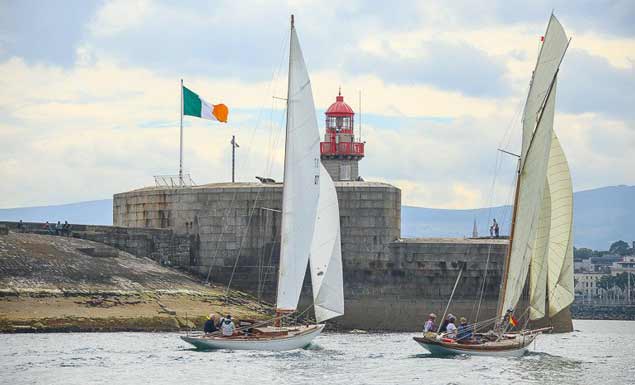 An enduring image. For sure we’ve used this photo before, of the restored Dublin Bay 24 Periwinkle (Chris Craig & David Espey) and the 1897 cutter Myfanwy (Rob Mason) racing for the entrance to Dun Laoghaire Harbour. But it perfectly captures the mood of idyllic regatta sailing in a classic setting. Photo: Afloat.ie
An enduring image. For sure we’ve used this photo before, of the restored Dublin Bay 24 Periwinkle (Chris Craig & David Espey) and the 1897 cutter Myfanwy (Rob Mason) racing for the entrance to Dun Laoghaire Harbour. But it perfectly captures the mood of idyllic regatta sailing in a classic setting. Photo: Afloat.ie
Yet always the powers-that-be are on the lookout for ways to make their annual regatta – whatever its form – even more successful in the following year. As the old saying would have it, things have to change all the time if they’re going to stay the same. Nevertheless, once a successful format has been established, it’s a matter of making small tweaks rather than major changes, and the underlying policy still has to be devoted to making people very well aware that the regatta is taking place, and that its success depends every bit as much on enthusiastic participants as it does on a significant number of volunteers at every level doing their bit to make sure everything runs smoothly.
The most visible side of this is the running of the club’s hospitality machine ashore. But don’t for one nano-second underestimate the importance of the Race Committee getting it right afloat, with efficiently run racing being largely completed around 4 o’clock in the afternoon being the ideal target.
There are endless historical precedents for the importance of competitive sport in the regatta format. Genteel if highly-structured sailing in company in the original style of the Water Club of the Harbour of Cork way back in the 1720s was soon no longer enough, and even the Water Club itself was actively promoting racing events at least by 1765, and probably earlier.
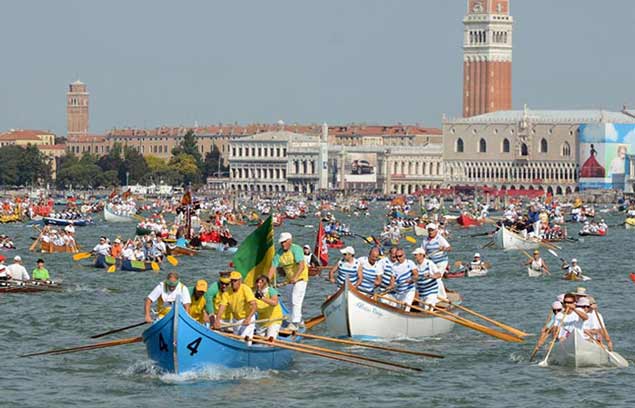 Modern racing gondolas in Venice, with fully-crewed boats. The word “regatta” is thought to be of Venetian origin, used since the 1650s for gondola contests
Modern racing gondolas in Venice, with fully-crewed boats. The word “regatta” is thought to be of Venetian origin, used since the 1650s for gondola contests
But way beyond that, the very word “Regatta” implied competition. It first emerged in the 1650s in Venice as the name for a race among the gondoliers on the Grand Canal. In the still very-active Venetian dialect (I once raced offshore with a speaker of it, and even for my cloth ears, it was unmistakable), “regatta” boiled down to translating as “contention for mastery” – the competitive element was paramount.
Thus although we know there was sailing in and around Dublin Bay from the 1600s onwards, it wasn’t until 1828, when the first regatta was staged in the then-new Kingstown Harbour, that we get any matter-of-fact reference to it. The reporting of sporting events afloat and ashore generated newsprint much more readily than the vague activity of sailing for relaxation, and it provided an image which still talks to us down the years.
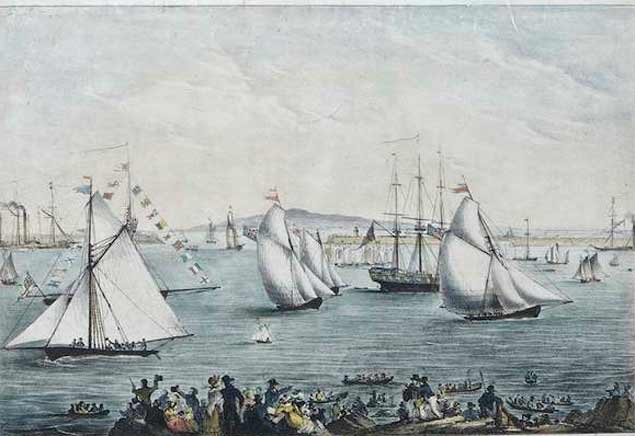 The daddy of them all. This basic but informative picture from 1828 is the clearest record of the first Kingstown regatta. Lord Erroll’s 42-ton cutter Liberty (right) is winning from Colonel Madden’s 69-ton cutter Ganymede which is narrowly ahead of the Rev D. George’s 37-ton cutter Thetis. 190 years later, regattas at this historic venue continue to reinvent themselves while somehow managing to seem the same in order to continue a remarkable tradition.
The daddy of them all. This basic but informative picture from 1828 is the clearest record of the first Kingstown regatta. Lord Erroll’s 42-ton cutter Liberty (right) is winning from Colonel Madden’s 69-ton cutter Ganymede which is narrowly ahead of the Rev D. George’s 37-ton cutter Thetis. 190 years later, regattas at this historic venue continue to reinvent themselves while somehow managing to seem the same in order to continue a remarkable tradition.
These days, the developing theme seems to be a neat over-lapping of championships, or the inclusion of established events in a style reminiscent of expanding Christianity taking over ancient Pagan festivals such as Easter, and giving them a new meaning
Only three weeks ago, we were looking at the success of the new Wave Regatta at Howth, which successfully included the time-honoured Lambay Race. Today, the National YC Regatta includes a guaranteed increase in boat numbers, thanks to being the first race of the new Laser Regatta Series.
In our era of limited time for people with a variety of leisure interests, this simple idea is a stroke of genius. The Dublin Bay Laser fleet, captained by Ross O’Leary, have just announced a handy new series based on Laser racing in the National YC regatta today and the Royal Irish YC regatta on June 30th, with the three-part series concluded and the prizes distributed at the Royal St George YC Regatta on July 7th.
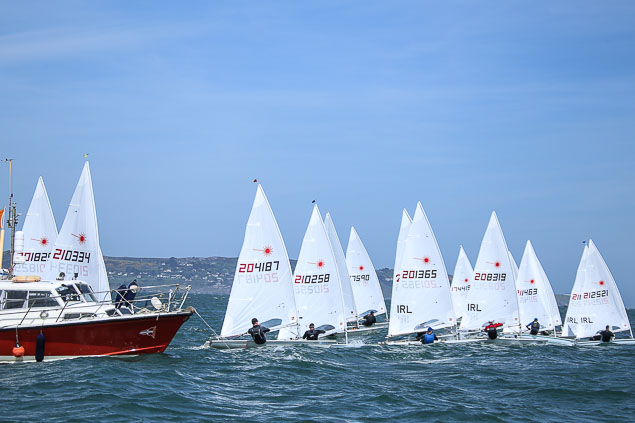 Perfect sailing conditions for Lasers in Dublin Bay. The simple but imaginative concept of a three regatta series for the class, starting today and concluding with the Royal St George YC Regatta on July 7th, is meeting with wide approval. Photo: Afloat.ie
Perfect sailing conditions for Lasers in Dublin Bay. The simple but imaginative concept of a three regatta series for the class, starting today and concluding with the Royal St George YC Regatta on July 7th, is meeting with wide approval. Photo: Afloat.ie
Meanwhile, from across Dublin Bay, there has been a similar leap of the imagination by the Howth Seventeen class. When you’ve been in existence for 120 years, significant anniversaries come with increasing frequency, and some bright spark has noticed that 2018 marks the 30th anniversary of the resumption of new building in the class. It was in 1988 – something like 74 years since a Seventeen had last been newly built – that the two new Howth Seventeens were built in a shed at Howth Castle.
We still think of those two boats Erica and Isobel as new, even though others have appeared more recently. Be that as it may, today the two-day celebration of their 30th Anniversary is going to get under way with the class racing from Howth to Dun Laoghaire and the National Yacht Club regatta, while back in Howth tomorrow they’ll cram in the Single-Handed race, the Crews’ race and the Ladies’ race rounded out by a barbecue.
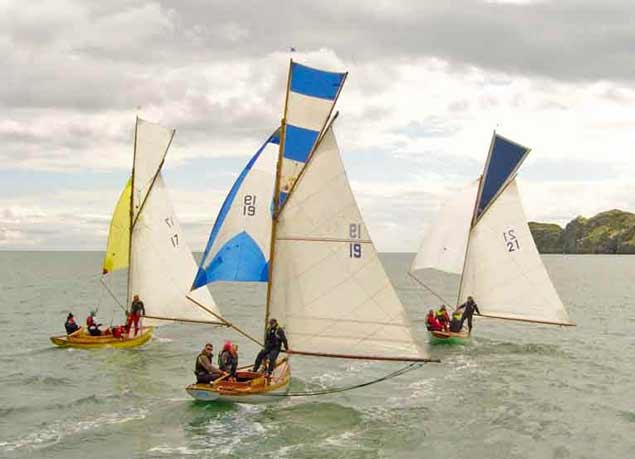 When a class is 120 years old, there’ll always be some date worthy of celebration coming along. This Howth Seventeen trio includes (left to right) Oonagh built 1909, Isobel 1988, and Orla 2017. Photo Neil Murphy
When a class is 120 years old, there’ll always be some date worthy of celebration coming along. This Howth Seventeen trio includes (left to right) Oonagh built 1909, Isobel 1988, and Orla 2017. Photo Neil Murphy
The NYC hospitality machine will be able to accommodate them on Day One with style as their 2018 regatta moves the Club towards the big one, its own 150th Anniversary in 2020. As a tester along the way, they host the Flying Fifteen World Championship next year, 2019. And who knows what other special attractions will come up to be staged with the smooth and unfussed style of this friendly club.
But before the conviviality takes over later this afternoon, there’s serious racing business to be done, and all eyes will inevitably be on the hottest class in the bay, the J/109s. In Irish waters at least, the Andrew Algeo-helmed Juggerknot is currently on a hugely successful roll, even if the Kelly family’s Storm did great things in Scotland last month, while the Shanahans in Ruth lodged an ISORA win. Either way, quarter will neither be given nor expected, while a major club’s annual regatta provides the ideal setting for such a battle royal, with jousting afloat while the flags flutter ashore.
 Just the job for a spot of nautical jousting……the very full length bowsprit on Sean Walsh’s Heard 28 Tir na nOg, berthed off the National Yacht Club on Regatta Day. Photo: W M Nixon
Just the job for a spot of nautical jousting……the very full length bowsprit on Sean Walsh’s Heard 28 Tir na nOg, berthed off the National Yacht Club on Regatta Day. Photo: W M Nixon
































































